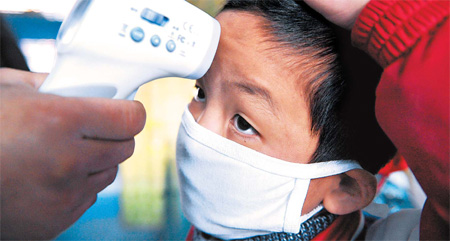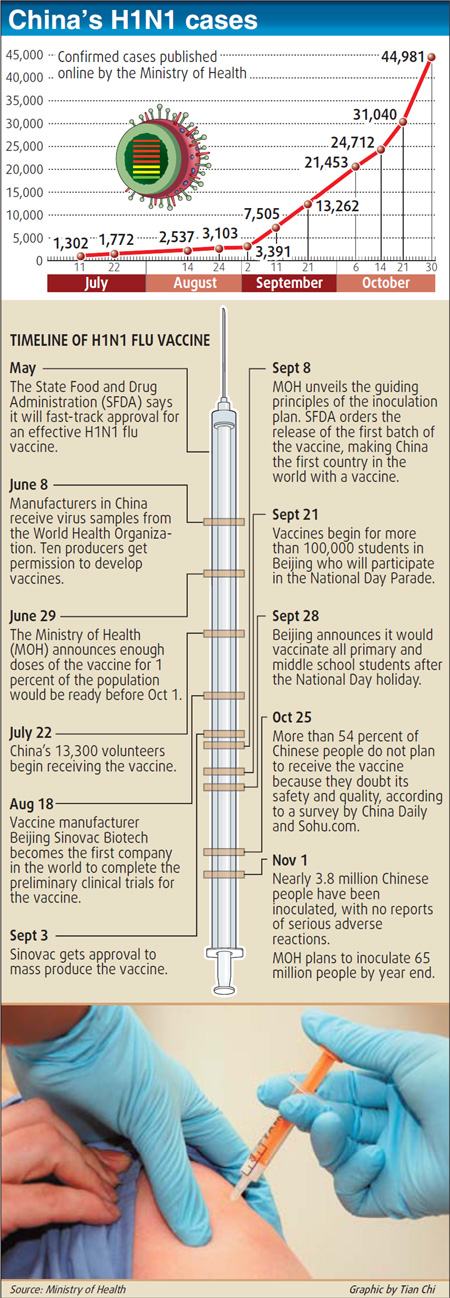
A pupil receives a temperature check at the Beiguan Primary School in Yan'an, Northwest China's Shaanxi province, yesterday.
In October, the H1N1 flu pandemic killed seven people on the Chinese mainland, stoking the public's fears, and leading them to wonder what the death toll of the disease will be.
A multitude of comments posted by concerned netizens have flooded the Internet recently, particularly after the latest H1N1 deaths of healthy young students. Some parents even kept schoolchildren at home as a precaution.
In response, health minister Chen Zhu tried to ease the mounting fear. "There is no need to panic and the pandemic is still well under control," he said last week.
The latest nationwide survey, however, showed that more than 80 percent of flu patients in the country tested positive for H1N1. In September, that figure was only about 20 percent across the nation.
The latest Ministry of Health tally showed that as of Nov 1, China has reported about 47,500 H1N1 flu cases on the mainland, including 104 severe cases and seven fatalities.
A 14-year-old middle school student in Changning city of central Hunan province died on Saturday, becoming the latest victim killed by the virus.
Experts are expecting the numbers to surge in most parts of China because the country has entered the peak flu season of autumn and winter.
About 10 to 20 percent of the population might get infected, estimated Liang Wannian, deputy director of emergency response office under the Ministry of Health.
Containing H1N1
Meanwhile, efforts to contain the outbreak and mitigate the potential impact, like averting concentrated outbreaks, have been intensified.
He Xiong, deputy director of the Beijing Centers for Diseases Control and Prevention (CDC), said the fatality rate is fairly low given the number of infections.
In late September, China rolled out its nationwide vaccination program. The priority groups were students, the elderly, medical workers and those holding important public service posts.
As the virus keeps spreading, more severe cases and deaths are unavoidable, which follows natural pattern as a virus evolves, he explained.
"At the moment, nothing that has happened is abnormal or unexpected," he told China Daily last week.
The public, however, is skeptical.
"Seemingly the virus is running wild and we're all a little bit scared of the pandemic," said Liu Jie, a 29-year-old civil servant in Beijing, who decided to get the H1N1 vaccination.
Previously she refused the shot for fear of potential side effects. "When the young man in Beijing died from H1N1, I just changed my mind," Liu said. "The risk from the virus is far more severe than from the vaccine."
National emergency in US
US President Barack Obama issued an H1N1 national emergency in late October, and this also prompted Liu to change her mind. World Health Organization (WHO) officials, however, clarified briefly that the US declaration didn't indicate worsening conditions either in US or the world.
"In China, the pandemic has so far evolved steadily towards more cases overall, including more severe cases and more deaths," said Vivian Tan, press officer with the WHO Beijing Office last week.
"As the H1N1 virus itself has shown no signs of mutation, current measures by Chinese authorities are appropriate," she stressed.

Learning about the flu
At present, top priorities for flu containment by Chinese health authorities include educating the public, particularly the groups with a higher risk, about prevention measures. Another priority is rapid treatment of patients, particularly those with heavy symptoms.
Some 80 percent of new infections in Beijing happened on school campuses, said officials at the local health bureau. More than 90 percent of the patients were younger than 30.
Public service announcements encouraging the general public to practice good hygiene, including frequent hand washing, were regularly aired on TV stations throughout the country.
"These efforts need to be maintained at a high level," added Tan.
The organization predicted yesterday that the H1N1 flu epidemic may not end until 80 percent of global population gets infected. Liang Wannian warned in August that tens of millions of people in China could get infected by H1N1 with millions seeking medical help.
"That would stress China's limited intensive care capacity, even in big cities like Beijing and Shanghai," warned Zeng Guang, chief epidemiologist with China CDC.
"We have to plan for the worst and make the best preparations," said deputy director He Xiong.
Getting ready for H1N1
All parts of China are gearing up for the acute challenge: expanding the vaccination schedule, training medical workers, and organizing supplies including antiviral drugs and other medical equipment like respiratory machines.
Since the onset of the potentially deadly virus on the mainland in May, the State Council has held several executive meetings to address the pandemic and allocated five billion yuan for flu prevention and control.
"At maximum treatment capacity in Beijing, we are able to deliver quality medical care for one third of the patients, particularly the severe cases," He said.
In the worst-case scenario, when the number of severe patients exceeds the hospitals' capacity, public venues including schools and hotels would be used to accommodate patients, he added.
"We will try every means to prevent that from happening," he said. "So far most of the H1N1 patients just showed mild symptoms."
Tan also urged the Chinese government to strengthen health facilities, making sure there is enough capacity to cope with the potential increase in severe cases without neglecting other non-H1N1 patients.
Major challenges ahead
Deputy director He agreed with Tan, urging more forceful implementation of rules to combat the pandemic among all stakeholders, ranging from the government to schools to the general public.
"Relative countermeasures and policies have been in place for a long time and there should be no slackness in executing that," he said.
Schools have always been a priority for prevention programs and information, according to officials.
In early September, when the new school term opened in China, the Ministry of Health and the Ministry of Education jointly issued a notice asking education institutions nationwide to avoid student assemblies to avert potential mass infections.
However, top-notch Beijing University of Aeronautics and Astronautics held military training for its freshman students off campus.
The country's fourth H1N1 victim, who had attended the training and got infected there, died on Tuesday.
Sources with the university said the school authority risked breaking the rule by organizing the off-campus training to make way for some 4,000 visiting participants of the "Challenge Cup," a national competition in science and technology.

The event, dubbed the Science Olympics for Chinese undergraduates, is being held by the university this year and opened there last Wednesday.
The same day, the Beijing health bureau reported the death of the 18-year-old male student from H1N1 flu.
"Without the military training, the death might have been avoided," He said.
Stockpiled supplies
Officials have stockpiled antiviral drugs, mostly Tamiflu and vaccines. But with the virus hitting China even harder, shortages are possible, and may already be a reality, experts warned.
In June, experts revealed that by then China only had enough Tamiflu for about 0.6 percent of the population.
Fortunately, some traditional Chinese medicines showed promise in treating the virus, though not for severe cases.
Since late September, when vaccinations began, China has inoculated about 3.8 million people against H1N1.
Health Minister Chen Zhu vowed to have 65 million people inoculated by the end of year and to prepare 100 million doses by next March.
"I believe 5 percent is based on the production capacity of pandemic H1N1 vaccine manufacturers in China, which was a start and would increase next year," said Vivian Tan.
"For now, the 5 percent (mostly high-risk groups) who get the vaccine will be protected against H1N1 infection. Vaccinated people will also indirectly protect the people around them as they will not be sources of transmission," she added.
Vaccinations worldwide
WHO plans to distribute 200 million doses of H1N1 flu vaccine to 100 developing countries soon. China is not on the list for now, According to Tan.
"China has not asked for WHO's help to supplement its vaccine supplies," said Tan.
As a vaccine-producing country, China, which does not have enough H1N1 vaccine to go around, is still in a much better position than many developing countries that do not produce their own vaccine and have no access to it, she added.
Crowded hospitals
As the nationwide vaccination schedule expands to prevent new infections, hospitals across the nation are bearing the brunt of a sharply increasing number of flu patients.
Authorities ordered intensified efforts by hospitals nationwide to further enhance medical care capacity, particular for severe cases.
Previously, Ministry of Health officials warned that people in the western regions are in more danger of H1N1 influenza compared to their eastern counterparts due to inadequate medical resources.
Health Minister Chen Zhu said the ministry would help improve the ability of flu prevention and control in the west, including training local medical staff and supplying vaccines and medicines.
Within hospitals, sound measures should be taken to prevent secondary H1N1 infections, said the notice issued by the Ministry of Health.
In Beijing, some medical workers became infected while treating H1N1 patients, said He Xiong, who declined to report the exact number.
More importantly, "the public should also play their part in pandemic prevention," He Xiong urged.
People should practice basic hygiene like proper and frequent hand washing as a permanent habit, he said.
"We hope the practice could be kept as a health legacy from the pandemic," he said.
taken from : China Daily



No comments:
Post a Comment